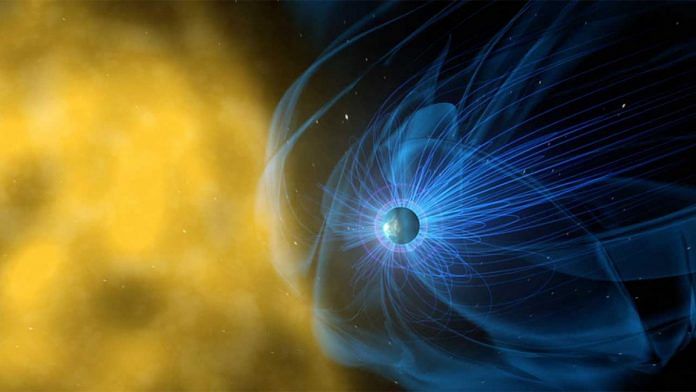New Australian study reveals turning point in Earth’s history
Rings on ancient trees in New Zealand have revealed that the Earth’s magnetic field temporarily broke down 42,000 years ago, sparking major climactic shifts that led to global environmental change and mass extinctions.
A new study by Australian researchers has revealed a dramatic turning point in Earth’s history, which was marked with electrical storms, widespread aurorae (natural electrical phenomenon characterised by the appearance of reddish or greenish light in the sky) and cosmic radiation.
This period is being called the ‘Adams Transitional Geomagnetic Event’, or ‘Adams Event’, in a tribute to noted science fiction author Douglas Adams, who wrote The Hitchhiker’s Guide to the Galaxy.
While scientists already knew the magnetic poles temporarily flipped around 41-42,000 years ago, they did not know exactly how it impacted life on Earth.
The team was able to create a detailed timescale of how Earth’s atmosphere changed during this time by analysing rings on the ancient kauri trees. Read more here.
First blackhole ever detected was much larger than thought
Scientists have now found that the first black hole ever detected was actually much larger than it was originally calculated. The research has led astronomers to reconsider their existing knowledge about black holes, arguably the universe’s most mysterious objects.
Cygnus X-1 is one of the closest black holes to Earth and was first discovered in 1964 when a pair of Geiger counters, which are instruments used for detecting and measuring ionizing radiation, were carried aboard a sub-orbital rocket launched from New Mexico.
The object was the focus of a famous scientific wager between British physicist Stephen Hawking and American physicist Kip Thorne, with Hawking actually betting in 1974 that it was not a black hole. But Hawking conceded the bet in 1990.
Using the Very Long Baseline Array — a continent-sized radio telescope made up of 10 dishes spread across the US — a team from the International Centre for Radio Astronomy Research was able to take fresh measurements for the blackhole.
The measurements show the black hole is 20 per cent further away than previously thought and is 21 times the mass of the Sun, making it the most massive black hole ever detected without the use of gravitational waves. Read more about this here.
Also read: 1,000 yrs for a trip around Sun — scientists map orbit of most distant object in solar system
Sea snail venom could treat malaria
US scientists have found that the venom of a species of sea snail called Conus nux could potentially treat malaria.
Severe forms of malaria may be deadly even after treatment with existing parasite-killing drugs. Even vaccines for malaria have proved less than moderately effective.
The new study paves the way for developing novel and cost-effective therapies against severe malaria.
Toxins from cone snails, or conotoxins, disable prey by specifically modulating their central nervous system by disrupting protein to protein interactions. The new study suggests that these toxins also have the ability to disrupt the protein interactions that directly contribute to the development of the malaria pathogen.
The researchers analysed Conus nux collected off the Pacific coast of Costa Rica. Read more here.
Mini bile ducts grown in lab could help repair damaged liver
Scientists have used a technique to grow miniature versions of bile ducts — which act as the liver’s waste disposal system — in the lab, which can be used to repair damaged human livers.
These ‘mini-organs’ or organoids could help develop cell therapies to treat liver disease. These organoids can act as replacement parts that can be used to restore a patient’s own liver to health or to repair damaged organ donor livers, so that they can still be used for transplantation.
Malfunctioning bile ducts are behind one-third adult and 70 per cent children’s liver transplantations. There is also a shortage of liver donors, which means that only a limited number of patients can benefit from transplants.
Organoids can not only help bridge this demand-supply gap, but also serve as an appropriate model to test the safety and efficacy of various drugs and products in humans before embarking on clinical trials.
The team from University of Cambridge in the UK demonstrated the effectiveness of their technique by repairing livers deemed unsuitable for transplantation due to bile duct damage. Read more here.
Calf of rare whale spotted in European waters
A video of a recently-born North Atlantic right whale calf — one of the world’s most endangered whales — has excited scientists all over the world.
The 47-second video, recorded by a team of Spanish divers, shows a four-metre whale calf, which appeared to be alone, in the Atlantic. This was an important sighting because the North Atlantic right whale was considered extinct from European waters 100 years ago.
The whale calf was spotted thousands of miles away from the species’ usual haunts along the eastern coasts of Canada and the US.
A few previous sightings of the whale in European waters had been thought to be whales with a penchant for transatlantic journeys.
However, Natacha Aguilar, a marine biologist at the University of La Laguna in Spain’s Tenerife, noted that “it could suggest that the species could be starting to recolonise the north Atlantic on the European and African side”. However, this is a rather unlikely theory.
Since 2017, 47 North Atlantic right whales have been found dead or seriously injured and the species has dwindled to fewer than 400 members. Read more about this here.
Also read: Mysterious diseases in chimpanzees at Sierra Leone sanctuary linked to bacteria




Hello how are you doing
But andh bhakts said India was formed 1,00,000 years ago and not in 1947
Who told you India was formed in 1947
Now you blame the earth for it!
Well done!